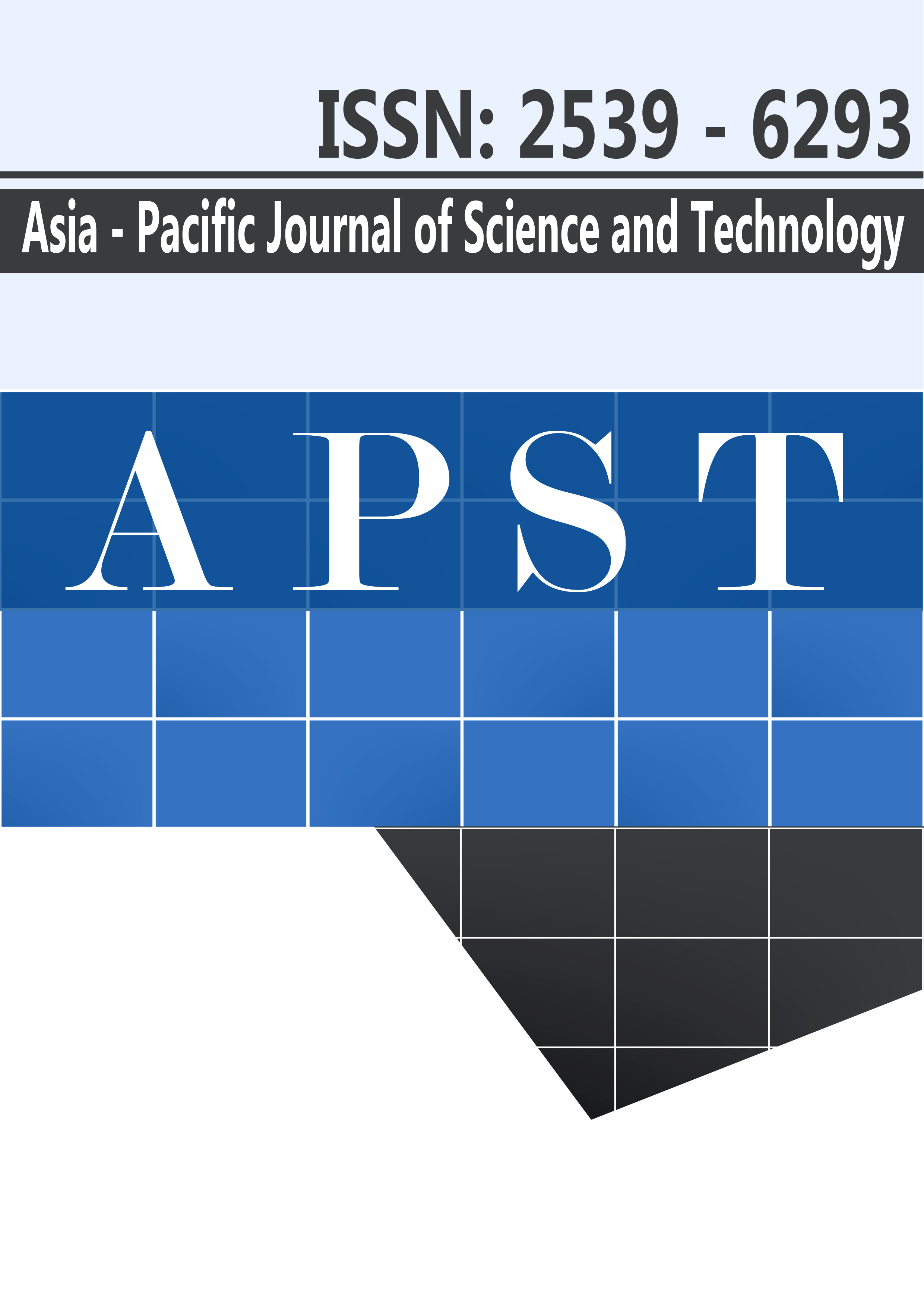Effect of BA and chitosan on In vitro Growth of Musa (ABB Group) ‘Kluai Namwa Mali-Ong’
Main Article Content
Abstract
Fruit crops are very important in agricultural production. Bananas are the fourth most consumed food in the world, behind rice, wheat and maize. Despite its significant commercial value, banana production is faced with the problem of unreliable and unsafe planting materials, which hinder its production. Conventional planting materials (suckers) are of poor quality and also not enough to meet the increasing demand. Tissue culture techniques can however be exploited in solving this problem. Nevertheless, there are a lot of challenges hindering the micropropagation of banana. These challenges need to be addressed to enhance the effectiveness of this technique in banana production. The effect of chitosan on in vitro growth of micropropagated Musa (ABB Group) ‘Kluai Namwa Mali-Ong’ (ABB) was studied. Plantlets were cultured on MS medium supplemented with 0 and 5 mg/l Benzyladenine (BA) and chitosan at the concentrations of 0, 5, 10, 15, and 20 mg/l. The experiment was set up using Completely Randomized Design (CRD) with 5 replications. After 4 months, explants cultured on MS medium supplemented with 5 mg/l BA and 10 mg/l chitosan produced the maximum number of shoots (9.80±0.3 shoots/explant) and buds (2.25±0.3 buds/explant). The highest number of roots (2.67±0.4 roots/explant) were identified on plantlets cultured on MS medium supplemented with only 20 mg/l of chitosan. Supplementing MS medium with chitosan for the micropropagation of banana in this study helped to accelerate growth by increasing the number of shoots.
Article Details
References
[2] Murashige T, Skoog F. A revised medium for rapid growth and bioassays with tobacco tissue cultures. Physiol Plant. 1962;15:473-97.
[3] Massimo M, Cerana R. Chitosan effect on plant systems. Int J Mol Sci. 2016;17:996-1011.
[4] Ben‐Shalom N, Ardi R, Pinto R, Aki C, Fallik E. Controlling gray mould caused by Botrytis cinerea in cucumber plants by means of chitosan. Crop Prot. 2003;22:285‐90.
[5] Photchanacha S, Singkaew J, Thamthong J. Effects of chitosan seed treatment on colletotrichum sp and seedling growth of chili cv. Jinda Acta Hortic. 2006;712:585-88.
[6] Dörnenburg H, Knoor D. Elicitation of chitinases and anthraquinones in Morinda citrifolia cell cultures. Food Biotechnol. 1994;8:57–59.
[7] Heena P, Krishnamurthy R. Elicitors in plant tissue culture. J Pharmacogn Phytochem. 2013;2:60-65.
[8] Yu LJ, Lan WZ, Qin WM, Jin WW, Xu HB. Oxidative stress and taxol production induced by fungal elicitor in cell suspension cultures of Taxus chinensis. Brief communication. Biol Plant. 2002;45:459–61.
[9] Putalun W, Luealon W, De-Eknamkul W, Tanaka H, Shoyama Y. Improvement of artemisinin production by chitosan in hairy root cultures of Artemisia annua L. Biotechnol Lett. 2007;29:1143–6.
[10] Nge KL, New N, Chandrkrachang S, Stevens WF. Chitosan as a growth stimulator in orchid tissue culture. Plant Sci. 2006;170:1185–90.
[11] Kowalski B, Terry FJ, Herrera L, Peñalver DA. Application of soluble chitosan in vitro and in the greenhouse to increase yield and seed quality of potato minitubers. Potato Res .2006;49:167–76.
[12] Vuylsteke D, Lanhe E. Feasibility of in vitro propagation of bananas and plantains. Trop Agric Res. 1985;62:323-8.
[13] Venkatachalam L, Sreedhar RV, Bhagyalakshmi N. Micro propagation in banana using high levels of cytokinin does not involve any genetic change as revealed by RAPD and ISSR markers. Plant Growth Regul. 2007;51:192-205.
[14] Bairu MW, Strik WA, Dolezal K, Staden JV. The role of topolins in micro propagation and somaclonal variation of banana cultivars ‘Williums’ and ‘Grand Naine’ (Musa spp. AAA). Plant Cell Tissue Organ Cult. 2008;95:373-9.
[15] Strosse H, Van den Houwe I, Panis B. Banana cell and tissue culture: Review. In: Jain SM, , Swennen R, editors. Banana improvement: cellular, molecular biology and induced mutations. Polymouth, U.K:Science Publishers Inc.; 2004. pp. 1–12.
[16] Hui AV, Bhatt A, Keng LK.. Micropropagation of Musa acuminata x M. balbisiana cv. Pisang Awak (ABB genome) and three other cultivars. Pak J Bot. 2012;44:777-80.
[17] Kanchanapoom K, Pimonlthai P, Kanchanapoom K. The effect of chitosan on regeneration of Lily (Lilium Longiflorum Thumb. ‘Ester Lily’) from bulb scale explants cultured in vitro. Propag Ornam Plants. 2012;12:127-9.
[18] Vacin E, Went F. Some pH changes in nutrient solutions. Bot Gaz 1949;110:605 –18.
[19] Samarfard S, Kadir MA, Kadzimin SB, Ravanfar S, Saud HM. Genetic stability of in vitro multiplied Phalaenopsis gigantean protocorm-like bodies as affected by chitosan. Not Bot Horti Agrobot Cluj Napoca. 2013;41:177-83.
[20] Nahar SJ, Kazuhiko S, Li HC, Kaewjampa N. Effect of plant growth regulators on organogenesis in protocorm-like body (PLBs) of Cymbidium dayanum in vitro. J Agric Biol Sci. 2011;6:28–33.
[21] Santiwong R, Limpanavech P, Chintapakorn Y. Effects of chitosan on growth of stevia (Stevia rebaudiana Bertoni) in vitro. Tha J Bot. 2012;4:93-99.
[22] Boonkerd N, Chandrkrachang S, Stevens WF. Effect of chitin on nodulation N2 fixation rhizobia-soybean symbiosis, chitin and chitosan. The 2nd Asia Pacific Symposium; November; Bangkok, Thailand; 1996. p. 183-7.

